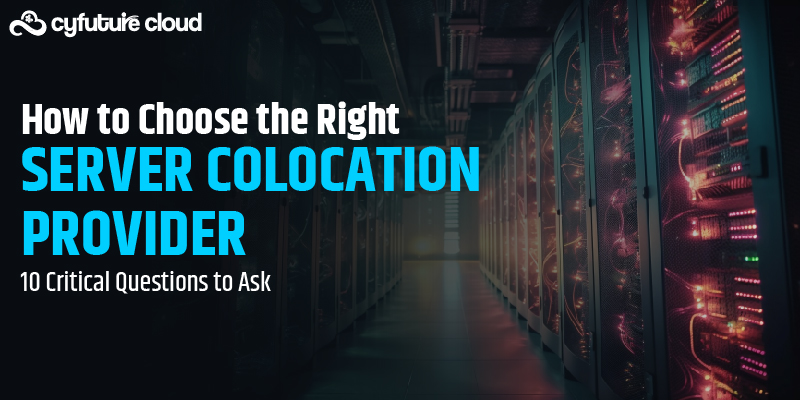Get 69% Off on Cloud Hosting : Claim Your Offer Now!
- Products
-
Compute
Compute
- Predefined TemplatesChoose from a library of predefined templates to deploy virtual machines!
- Custom TemplatesUse Cyfuture Cloud custom templates to create new VMs in a cloud computing environment
- Spot Machines/ Machines on Flex ModelAffordable compute instances suitable for batch jobs and fault-tolerant workloads.
- Shielded ComputingProtect enterprise workloads from threats like remote attacks, privilege escalation, and malicious insiders with Shielded Computing
- GPU CloudGet access to graphics processing units (GPUs) through a Cyfuture cloud infrastructure
- vAppsHost applications and services, or create a test or development environment with Cyfuture Cloud vApps, powered by VMware
- Serverless ComputingNo need to worry about provisioning or managing servers, switch to Serverless Computing with Cyfuture Cloud
- HPCHigh-Performance Computing
- BaremetalBare metal refers to a type of cloud computing service that provides access to dedicated physical servers, rather than virtualized servers.
-
Storage
Storage
- Standard StorageGet access to low-latency access to data and a high level of reliability with Cyfuture Cloud standard storage service
- Nearline StorageStore data at a lower cost without compromising on the level of availability with Nearline
- Coldline StorageStore infrequently used data at low cost with Cyfuture Cloud coldline storage
- Archival StorageStore data in a long-term, durable manner with Cyfuture Cloud archival storage service
-
Database
Database
- MS SQLStore and manage a wide range of applications with Cyfuture Cloud MS SQL
- MariaDBStore and manage data with the cloud with enhanced speed and reliability
- MongoDBNow, store and manage large amounts of data in the cloud with Cyfuture Cloud MongoDB
- Redis CacheStore and retrieve large amounts of data quickly with Cyfuture Cloud Redis Cache
-
Automation
Automation
-
Containers
Containers
- KubernetesNow deploy and manage your applications more efficiently and effectively with the Cyfuture Cloud Kubernetes service
- MicroservicesDesign a cloud application that is multilingual, easily scalable, easy to maintain and deploy, highly available, and minimizes failures using Cyfuture Cloud microservices
-
Operations
Operations
- Real-time Monitoring & Logging ServicesMonitor & track the performance of your applications with real-time monitoring & logging services offered by Cyfuture Cloud
- Infra-maintenance & OptimizationEnsure that your organization is functioning properly with Cyfuture Cloud
- Application Performance ServiceOptimize the performance of your applications over cloud with us
- Database Performance ServiceOptimize the performance of databases over the cloud with us
- Security Managed ServiceProtect your systems and data from security threats with us!
- Back-up As a ServiceStore and manage backups of data in the cloud with Cyfuture Cloud Backup as a Service
- Data Back-up & RestoreStore and manage backups of your data in the cloud with us
- Remote Back-upStore and manage backups in the cloud with remote backup service with Cyfuture Cloud
- Disaster RecoveryStore copies of your data and applications in the cloud and use them to recover in the event of a disaster with the disaster recovery service offered by us
-
Networking
Networking
- Load BalancerEnsure that applications deployed across cloud environments are available, secure, and responsive with an easy, modern approach to load balancing
- Virtual Data CenterNo need to build and maintain a physical data center. It’s time for the virtual data center
- Private LinkPrivate Link is a service offered by Cyfuture Cloud that enables businesses to securely connect their on-premises network to Cyfuture Cloud's network over a private network connection
- Private CircuitGain a high level of security and privacy with private circuits
- VPN GatewaySecurely connect your on-premises network to our network over the internet with VPN Gateway
- CDNGet high availability and performance by distributing the service spatially relative to end users with CDN
-
Media
-
Analytics
Analytics
-
Security
Security
-
Network Firewall
- DNATTranslate destination IP address when connecting from public IP address to a private IP address with DNAT
- SNATWith SNAT, allow traffic from a private network to go to the internet
- WAFProtect your applications from any malicious activity with Cyfuture Cloud WAF service
- DDoSSave your organization from DoSS attacks with Cyfuture Cloud
- IPS/ IDSMonitor and prevent your cloud-based network & infrastructure with IPS/ IDS service by Cyfuture Cloud
- Anti-Virus & Anti-MalwareProtect your cloud-based network & infrastructure with antivirus and antimalware services by Cyfuture Cloud
- Threat EmulationTest the effectiveness of cloud security system with Cyfuture Cloud threat emulation service
- SIEM & SOARMonitor and respond to security threats with SIEM & SOAR services offered by Cyfuture Cloud
- Multi-Factor AuthenticationNow provide an additional layer of security to prevent unauthorized users from accessing your cloud account, even when the password has been stolen!
- SSLSecure data transmission over web browsers with SSL service offered by Cyfuture Cloud
- Threat Detection/ Zero DayThreat detection and zero-day protection are security features that are offered by Cyfuture Cloud as a part of its security offerings
- Vulnerability AssesmentIdentify and analyze vulnerabilities and weaknesses with the Vulnerability Assessment service offered by Cyfuture Cloud
- Penetration TestingIdentify and analyze vulnerabilities and weaknesses with the Penetration Testing service offered by Cyfuture Cloud
- Cloud Key ManagementSecure storage, management, and use of cryptographic keys within a cloud environment with Cloud Key Management
- Cloud Security Posture Management serviceWith Cyfuture Cloud, you get continuous cloud security improvements and adaptations to reduce the chances of successful attacks
- Managed HSMProtect sensitive data and meet regulatory requirements for secure data storage and processing.
- Zero TrustEnsure complete security of network connections and devices over the cloud with Zero Trust Service
- IdentityManage and control access to their network resources and applications for your business with Identity service by Cyfuture Cloud
-
-
Compute
- Solutions
-
Solutions
Solutions
-
 Cloud
Hosting
Cloud
Hosting
-
 VPS
Hosting
VPS
Hosting
-
GPU Cloud
-
 Dedicated
Server
Dedicated
Server
-
 Server
Colocation
Server
Colocation
-
 Backup as a Service
Backup as a Service
-
 CDN
Network
CDN
Network
-
 Window
Cloud Hosting
Window
Cloud Hosting
-
 Linux
Cloud Hosting
Linux
Cloud Hosting
-
Managed Cloud Service
-
Storage as a Service
-
 VMware
Public Cloud
VMware
Public Cloud
-
 Multi-Cloud
Hosting
Multi-Cloud
Hosting
-
 Cloud
Server Hosting
Cloud
Server Hosting
-
 Bare
Metal Server
Bare
Metal Server
-
 Virtual
Machine
Virtual
Machine
-
 Magento
Hosting
Magento
Hosting
-
Remote Backup
-
 DevOps
DevOps
-
 Kubernetes
Kubernetes
-
 Cloud
Storage
Cloud
Storage
-
NVMe Hosting
-
 DR
as s Service
DR
as s Service
-
-
Solutions
- Marketplace
- Pricing
- Resources
- Resources
-
By Product
Use Cases
-
By Industry
- Company
-
Company
Company
-
Company
Can 2023 be the Year of Public Cloud Repatriation?
Table of Contents
Public cloud repatriation refers to the process of moving data and workloads that were previously hosted in a public cloud back to an on-premises or private cloud environment. This process can be driven by a variety of factors, including security concerns, regulatory compliance, and cost savings.
In recent years, there has been a growing trend of organizations moving their data and workloads to public clouds such as AWS, Azure, and Google Cloud. However, 2023 could be the year of public cloud repatriation 2023 as more organizations are beginning to re-evaluate the benefits of public cloud and are considering moving back to on-premises or private cloud environments.
One of the main reasons for this trend is the increasing concern over security in the public cloud. As more sensitive data is moved to the public cloud, there is a greater risk of data breaches and cyber attacks. Additionally, with the increasing number of high-profile security breaches and data leaks, organizations are becoming more aware of the potential risks of public cloud.
Another reason for the trend is the increasing complexity of regulatory compliance in the public cloud. Many industries, such as healthcare and finance, have strict regulations that must be followed when it comes to data storage and processing. As a result, organizations in these industries may find it difficult to comply with these regulations when using public cloud services.
Lastly, cost-saving is another major reason for the trend. As organizations continue to grow, they may find that the costs associated with using public cloud services become prohibitively expensive. Additionally, as more organizations move to the public cloud, the costs of these services are expected to rise.
The trend of public cloud repatriation is driven by a combination of security concerns, regulatory compliance, and cost savings. As a result, 2023 could be the year of public cloud repatriation.
Factors Driving Public Cloud Repatriation
Public cloud repatriation is driven by a variety of factors that can vary depending on the organization and industry. In general, the trend is driven by concerns over data privacy and security, regulatory compliance, and cost and performance optimization.
– Data privacy concerns: One of the main drivers of public cloud repatriation is data privacy concerns. With more sensitive data being stored in the public cloud, there is a greater risk of data breaches and cyber attacks. This is particularly true for organizations in industries such as healthcare and finance, which have strict regulations around data privacy.
– Security considerations: Security is also a major driver of public cloud repatriation. Organizations are becoming increasingly aware of the potential risks of public cloud, including the risk of data breaches and cyber attacks. Additionally, many organizations have compliance requirements that must be met when it comes to data security, and may find it difficult to comply with these regulations when using public cloud services.
– Regulations and compliance: Compliance with industry regulations is another important factor that can drive public cloud repatriation. Many industries have strict regulations around data storage and processing, and organizations may find it difficult to comply with these regulations when using public cloud services.
– Cost and performance optimization: Cost and performance optimization is another major driver of public cloud repatriation. As organizations continue to grow, they may find that the costs associated with using public cloud services become prohibitively expensive. Additionally, as more organizations move to the public cloud, the costs of these services are expected to rise.
The trend of public cloud repatriation is driven by a combination of factors, including data privacy and security concerns, regulatory compliance, and cost and performance optimization. As a result, organizations are increasingly considering moving their data and workloads back to on-premises or private cloud environments.
Impact on Businesses
The impact of public cloud repatriation on businesses can be both positive and negative, depending on the organization and industry.
Advantages of Public Cloud Repatriation
- Improved data security: By moving data and workloads back to on-premises or private cloud environments, organizations can improve their data security and reduce the risk of data breaches and cyber attacks.
- Better compliance and regulatory oversight: Public cloud repatriation can also help organizations comply with industry regulations and oversight by allowing them to have more control over their data and infrastructure.
- Cost savings: Organizations can also achieve cost savings by reducing their dependence on public cloud services, which can become expensive as the organization grows.
Challenges of Public Cloud Repatriation:
- Complexity of migration: Public cloud repatriation can be a complex process, and organizations may need to invest significant time and resources to migrate data and workloads back to on-premises or private cloud environments.
- Potential disruptions to business operations: The process of migration can also cause disruptions to business operations, and organizations may need to make temporary arrangements to ensure continuity of operations.
- Need for specialized expertise: Organizations may also need to invest in specialized expertise to manage the migration process and ensure that data and workloads are properly migrated and secured.
Overall, the decision to repatriate from public cloud to on-premises or private cloud environments depends on the specific needs and requirements of the organization. While the process can be challenging, it can also bring significant benefits in terms of data security, compliance, and cost savings.
Conclusion
In conclusion, public cloud repatriation is the process of moving data and workloads that were previously hosted in a public cloud back to an on-premises or private cloud environment. The trend of public cloud repatriation is driven by a combination of factors, including data privacy and security concerns, regulatory compliance, and cost and performance optimization.
Predictions for the future of public cloud repatriation
- As more organizations become aware of the potential risks of public cloud, we expect to see an increase in public cloud repatriation in the future.
- We also predict that the trend will continue to be driven by concerns over data privacy and security, regulatory compliance, and cost and performance optimization.
- Additionally, as more organizations move to the public cloud, the costs of these services are expected to rise, which could further drive the trend of public cloud repatriation.
Recommendations for businesses considering public cloud repatriation
- Organizations should carefully evaluate their specific needs and requirements before deciding to repatriate from public cloud to on-premises or private cloud environments.
- They should also consider the potential benefits and challenges of public cloud repatriation and weigh them against their current needs and capabilities.
- Organizations should also consider seeking specialized expertise to manage the migration process and ensure that data and workloads are properly migrated and secured.
Overall, public cloud repatriation is an important trend that organizations should consider as they evaluate their data storage and processing needs. While the process can be challenging, it can also bring significant benefits in terms of data security, compliance, and cost savings.
Recent Post

Stay Ahead of the Curve.
Join the Cloud Movement, today!
© Cyfuture, All rights reserved.
Send this to a friend

 Pricing
Calculator
Pricing
Calculator
 Power
Power
 Utilities
Utilities VMware
Private Cloud
VMware
Private Cloud VMware
on AWS
VMware
on AWS VMware
on Azure
VMware
on Azure Service
Level Agreement
Service
Level Agreement 


















